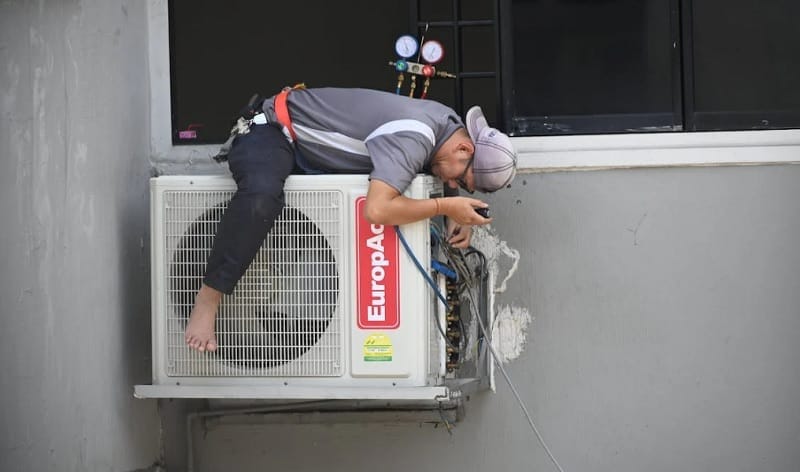Professional air conditioning installations are essential to getting the most from your new air conditioning system. A quality cooling contractor will assess your home to ascertain which size unit would best serve you.
Installation
Air conditioning installation entails numerous steps, each of which plays a vital role in the operation of your new system. As this is often a complicated process, professional installation services should be hired for the best results.
First, your installer will conduct an in-home assessment to ascertain which size air conditioning system best meets your needs and consider factors like usage patterns and any potential factors that could inhibit its performance. He will then give a price estimate and explore any financing solutions.
Once the agreement is inked, an installation team will begin work to remove your old outdoor unit, pour a concrete pad or install the unit directly on your roof as necessary, build up its area where it will reside if required, remove all indoor/outdoor ducting (ductwork/copper refrigerant lines), install a composite pad as well as any indoor ducting/copper refrigerant lines.
Next, your installer will vacuum the new system to at least five hundred microns as recommended by its manufacturer, to eliminate air and other non-refrigerant contaminants that can compromise comfort, energy efficiency, and safety. You can learn more about air quality by clicking the link.
Commissioning
HVAC systems play an essential role in controlling temperature and air quality in commercial buildings, so their design and installation must meet a stringent set of standards.
Commissioning is a comprehensive review that ensures your HVAC system performs exactly as designed, meeting all standard regulations in full.
An incorrect commissioning process can result in inefficiency, energy waste, and even mechanical failures, so its proper execution should never be left to an inexperienced technician or engineer. To ensure optimal results from commissioning procedures they should be performed by professionals with extensive industry knowledge.
The commissioning process comprises three stages: pre-commissioning, commissioning, and post-commissioning.
Pre-commissioning involves reviewing an HVAC system design and creating a commissioning plan; it is an essential step to prevent mistakes from happening before commissioning begins. At this stage, an experienced engineering professional verifies all air conditioning installations were carried out correctly by validating heat transfer execution, air balancing, and measuring water/air volumetric flow rates. They do this with a series of essential tests.
Once this work is done, the system is prepared for its run test by making sure all refrigerant pipework has been evacuated of moisture before powering up the outdoor unit and starting up the compressor for final sign-off by an engineer.
Maintenance
Like any piece of equipment, your air conditioner requires routine maintenance to remain efficient. Regular checks allow you to identify potential issues before they become costly repairs.
Your contractor will visit your home to collect crucial data on the existing system, such as its location and type of installation. They will also assess its existing cooling infrastructure – looking out for any duct leaks that might decrease the efficiency of cooling systems.
Step two of this project entails taking steps to remove the existing outdoor unit, which involves turning off its power at the breaker box and clearing away its surroundings. Any shrubs or foliage within two feet of the unit that could interfere with airflow should also be cleared away before installing new pads and hangers on it by your contractor. You can click the link: https://www.marthastewart.com/8067201/how-remove-rooted-trees-shrubs-garden for help clearing away shrubs.
Once connected to the existing refrigerant line set, the new outdoor unit will be added. These lines run from outdoor condenser to the indoor evaporator coil and contain refrigerant and oil; technicians will use special tools to remove and attach new line sets; they will also test for proper pressurization in each set before doing this step.
Repairs
An experienced HVAC technician will assess your home’s air duct system to determine which size of cooling system would best serve it.
The team will start by disassembling any outdated equipment. This may involve dismantling an indoor evaporator coil over your furnace and copper refrigerant lines as well as disassembling sheet metal plenum and disconnecting electrical wiring for your current air conditioner.
Please keep in mind that anyone handling refrigerants must possess an individual EPA certification.
Once the old equipment has been taken away, a composite pad will be installed as its replacement. Concrete pads tend to shift over time and cause irreparable damage; to avoid this scenario, a composite pad that can withstand vibrations would be much more suitable and last the life of the new air conditioning unit.
Once the new outdoor unit has been assembled, its refrigerant lines should be connected and brazed onto service valves. Next comes installation of the compressor which, if not done properly, could lead to air conditioner leakage.
Finally, any window-mounted flange should be securely fastened, and it is important that its weight can support itself before final assembly begins.







![Sara Saffari Age, Net Worth And Biography [2024] Sara Saffari](https://www.cyberockk.com/wp-content/uploads/2024/01/Sara-Saffari-218x150.jpg)
